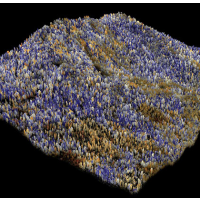Drought Blows Their Cover—58 Million Trees at “Severe” Risk
 Sequoia National Park. Brown is bad. (photo: courtesy of Greg Asner)
Sequoia National Park. Brown is bad. (photo: courtesy of Greg Asner)
Back in May, the U.S. Forest Service published a report (pdf) that calculated 12 million trees in California were killed by drought in 2014. “It is almost certain that millions more trees will die over the course of the upcoming summer,” the Forest Service’s Jeffrey Moore told the Los Angeles Times.
Researchers at Carnegie Institution for Science have an update. But instead of counting dead trees on the ground, they went airborne to measure the moisture in tree canopies across the state and compared the results to 2012.
They found “severe” canopy water content (CWC) losses of at least 30% in 58 million trees that might not spell mortality now, but “do point to rapid increases in the vulnerability of millions of trees.” That’s bad, but it could get worse. The report (pdf) says:
“If drought continues or reoccurs, there exists a pool of trees spread over millions of hectares of forests that may undergo sufficient CWC loss to result in death. . . . This pool could increase into the hundreds of millions of trees.”
The researchers found 888 million large trees in 41,000 square miles of forest had measurable loss of canopy moisture. “Even with temporary reprieves such as El Niño, we predict substantial future forest change,” more drought will be a killer.
The Carnegie researchers, flying a fixed-wing aircraft called the Carnegie Airborne Observatory (CAO), swept the sky with laser light to capture images of the vegetation canopy in vivid 3-D. They combined the data with high-resolution satellite monitoring going back four years.
Project leader Greg Asner said, “Continued airborne and satellite monitoring will enable actions on the ground to mitigate a cascade of negative impacts from forest losses due to drought, as well as aid in monitoring forest recovery if and when the drought subsides.”
Yes it will, but whether anyone on the ground actually does anything with the information remains to be seen. It will be a tricky business dealing with increases in pest infestations and other maladies in the forest as the trees weaken. Fire will become more of a threat.
Water rushing out of the mountains as the snow caps melt will evaporate faster without trees cooling the paths. Whole ecosystems will be wiped out. Once the forests are replaced by scrubland and grasslands they won’t be back anytime soon. “It's important that we understand what we're losing,” Asner told Newsweek.
–Ken Broder
To Learn More:
Here Are 58 Million Reasons to Care About California's Drought (by Zoë Schlanger, Newsweek)
California's Ongoing Drought Puts 58 Million Trees in Danger (by Samantha Mathewson, Nature World News)
California Drought Puts Tens of Millions of Big Trees at Risk: Study (by Matthew DeLuca, NBC News)
Drought Killed More Than 12 Million Forest Trees Last Year; Lawns Are Next (by Ken Broder, AllGov California)
Tens of Millions of Trees in Danger from California Drought (Carnegie Institution for Science)
Progressive Forest Canopy Water Loss During the 2012–2015 California Drought (by Gregory P. Asner, Philip G. Brodrick, Christopher B. Anderson, Nicholas Vaughn, David E. Knapp and Roberta E. Martin, Proceedings of the National Academy of Sciences) (pdf)
- Top Stories
- Controversies
- Where is the Money Going?
- California and the Nation
- Appointments and Resignations
- Unusual News
- Latest News
- California Forbids U.S. Immigration Agents from Pretending to be Police
- California Lawmakers Urged to Strip “Self-Dealing” Tax Board of Its Duties
- Big Oil’s Grip on California
- Santa Cruz Police See Homeland Security Betrayal in Use of Gang Roundup as Cover for Immigration Raid
- Oil Companies Face Deadline to Stop Polluting California Groundwater





